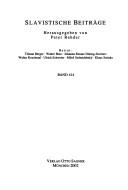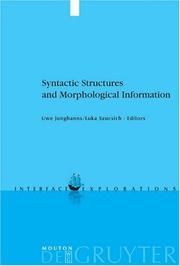| Listing 1 - 10 of 11 | << page >> |
Sort by
|
Book
Year: 2002 Publisher: Sagner
Abstract | Keywords | Export | Availability | Bookmark
 Loading...
Loading...Choose an application
- Reference Manager
- EndNote
- RefWorks (Direct export to RefWorks)

ISBN: 3876908191 Year: 2001 Publisher: Bern Peter Lang International Academic Publishing Group
Abstract | Keywords | Export | Availability | Bookmark
 Loading...
Loading...Choose an application
- Reference Manager
- EndNote
- RefWorks (Direct export to RefWorks)
Book
ISBN: 3954790289 Year: 2012 Publisher: Verlag Otto Sagner
Abstract | Keywords | Export | Availability | Bookmark
 Loading...
Loading...Choose an application
- Reference Manager
- EndNote
- RefWorks (Direct export to RefWorks)
Book
Year: 2001 Publisher: Frankfurt a.M. PH02
Abstract | Keywords | Export | Availability | Bookmark
 Loading...
Loading...Choose an application
- Reference Manager
- EndNote
- RefWorks (Direct export to RefWorks)
Ziel der vorliegenden Dissertation ist die Bestimmung des Status von nominalen Adverbialen innerhalb der Grammatik des Russischen, wobei ich in erster Linie eine syntaktische Analyse der genannten Adverbiale vornehme. Dabei steht sowohl deren 'externe' Struktur - d.h. die Einbettungsposition der Adverbiale in der Satzstruktur - als auch die 'interne' Struktur - d.h. der kategoriale Status von nominalen Adverbialen - im Zentrum der Untersuchung. Die Analyse des konfigurationell- syntaktischen Status dient als Ausgangspunkt, um die Kasusverhältnisse bei 'nackten' akkusativischen und instrumentalen Adverbialen zu erklären. Allerdings geht man davon aus, dass eine explanatorisch wie deskriptiv adäquate syntaktische Analyse nur unter Berücksichtigung der semantischen Komponente der Grammatik sinnvoll durchzuführen ist.
linguistics --- status --- grammar --- russian --- nomina --- adverbials --- Adjunktionspositionen von Adverbialen --- Adverbiale --- Aspektualität in Nicht-Aspektsprachen --- Funktionale Lizensierung von Adverbiale --- Informationsstruktur --- Instrumentale Adverbial --- Nominale --- Russischen --- Semantik --- Substitution und Ajunktion --- Syntax --- Szucsich
Book
Year: 2001 Publisher: Frankfurt a.M. PH02
Abstract | Keywords | Export | Availability | Bookmark
 Loading...
Loading...Choose an application
- Reference Manager
- EndNote
- RefWorks (Direct export to RefWorks)
Ziel der vorliegenden Dissertation ist die Bestimmung des Status von nominalen Adverbialen innerhalb der Grammatik des Russischen, wobei ich in erster Linie eine syntaktische Analyse der genannten Adverbiale vornehme. Dabei steht sowohl deren 'externe' Struktur - d.h. die Einbettungsposition der Adverbiale in der Satzstruktur - als auch die 'interne' Struktur - d.h. der kategoriale Status von nominalen Adverbialen - im Zentrum der Untersuchung. Die Analyse des konfigurationell- syntaktischen Status dient als Ausgangspunkt, um die Kasusverhältnisse bei 'nackten' akkusativischen und instrumentalen Adverbialen zu erklären. Allerdings geht man davon aus, dass eine explanatorisch wie deskriptiv adäquate syntaktische Analyse nur unter Berücksichtigung der semantischen Komponente der Grammatik sinnvoll durchzuführen ist.
status --- grammar --- russian --- nomina --- adverbials --- Adjunktionspositionen von Adverbialen --- Adverbiale --- Aspektualität in Nicht-Aspektsprachen --- Funktionale Lizensierung von Adverbiale --- Informationsstruktur --- Instrumentale Adverbial --- Nominale --- Russischen --- Semantik --- Substitution und Ajunktion --- Syntax --- Szucsich
Book
Year: 2001 Publisher: Frankfurt a.M. PH02
Abstract | Keywords | Export | Availability | Bookmark
 Loading...
Loading...Choose an application
- Reference Manager
- EndNote
- RefWorks (Direct export to RefWorks)
Ziel der vorliegenden Dissertation ist die Bestimmung des Status von nominalen Adverbialen innerhalb der Grammatik des Russischen, wobei ich in erster Linie eine syntaktische Analyse der genannten Adverbiale vornehme. Dabei steht sowohl deren 'externe' Struktur - d.h. die Einbettungsposition der Adverbiale in der Satzstruktur - als auch die 'interne' Struktur - d.h. der kategoriale Status von nominalen Adverbialen - im Zentrum der Untersuchung. Die Analyse des konfigurationell- syntaktischen Status dient als Ausgangspunkt, um die Kasusverhältnisse bei 'nackten' akkusativischen und instrumentalen Adverbialen zu erklären. Allerdings geht man davon aus, dass eine explanatorisch wie deskriptiv adäquate syntaktische Analyse nur unter Berücksichtigung der semantischen Komponente der Grammatik sinnvoll durchzuführen ist.
linguistics --- status --- grammar --- russian --- nomina --- adverbials --- Adjunktionspositionen von Adverbialen --- Adverbiale --- Aspektualität in Nicht-Aspektsprachen --- Funktionale Lizensierung von Adverbiale --- Informationsstruktur --- Instrumentale Adverbial --- Nominale --- Russischen --- Semantik --- Substitution und Ajunktion --- Syntax --- Szucsich
Book
ISBN: 9783876908199 Year: 2001 Publisher: Bern Peter Lang International Academic Publishers
Abstract | Keywords | Export | Availability | Bookmark
 Loading...
Loading...Choose an application
- Reference Manager
- EndNote
- RefWorks (Direct export to RefWorks)
The aim of the present dissertation is to determine the status of nominal adverbials within the grammar of Russian, with a primary focus on syntactic analysis of the adverbials mentioned. It stands both their 'external' structure - i. the embedding position of the adverbials in the sentence structure - as well as the 'internal' structure - i. the category status of nominal adverbials - in the center of the investigation. The analysis of the configurational-syntactic status serves as a starting point to explain the case-relations of 'naked' accusative and instrumental adverbials. However, it is assumed that an explanatory as well as descriptively adequate syntactic analysis is meaningful only if the semantic component of the grammar is taken into account.
Book
ISBN: 3631806043 3631806051 3631770111 Year: 2020 Publisher: Bern Peter Lang International Academic Publishing Group
Abstract | Keywords | Export | Availability | Bookmark
 Loading...
Loading...Choose an application
- Reference Manager
- EndNote
- RefWorks (Direct export to RefWorks)
This book assembles contributions dealing with language contact and areal linguistics. The goal of the book is to investigate linguistic convergence in Europe with a strong focus on the languages of Eastern Central Europe which show many remarkable similarities. The focus is put on a methodical and empirical component in the investigation of two or more languages in the context of possible language contact phenomena. Languages of Eastern Central Europe and adjacent parts of Europe use a considerable amount of common vocabulary due to the transfer of loanwords during a long period of cultural contact. But they also share several grammatical features—phonological, morphological and syntactic ones. This book tackles lexical and grammatical phenomena in language contact situations. The authors take up diachronic, synchronic and language acquisitional perspectives, and discuss methodological problems for the field.
Languages in contact --- Interference (Linguistics) --- Comparative linguistics. --- Europe, Eastern --- Languages. --- Comparative philology --- Philology, Comparative --- Historical linguistics --- Linguistic interference --- Bilingualism --- Language transfer (Language learning) --- Areal linguistics --- Areal --- Central --- Convergence --- Eastern --- European --- Grammatische Entlehnung --- Hungarologie --- Kontaktlinguistik --- Languages --- Lexikalische Entlehnung --- Slavistik --- Sprachlicher Transfer --- Szucsich --- Typologie
Book
ISBN: 3961101272 3961101280 9783961101276 Year: 2019 Publisher: Berlin Language Science Press
Abstract | Keywords | Export | Availability | Bookmark
 Loading...
Loading...Choose an application
- Reference Manager
- EndNote
- RefWorks (Direct export to RefWorks)
Advances in Formal Slavic Linguistics 2016 initiates a new series of collective volumes on formal Slavic linguistics. It presents a selection of high quality papers authored by young and senior linguists from around the world and contains both empirically oriented work, underpinned by up-to-date experimental methods, as well as more theoretically grounded contributions. The volume covers all major linguistic areas, including morphosyntax, semantics, pragmatics, phonology, and their mutual interfaces. The particular topics discussed include argument structure, word order, case, agreement, tense, aspect, clausal left periphery, or segmental phonology. The topical breadth and analytical depth of the contributions reflect the vitality of the field of formal Slavic linguistics and prove its relevance to the global linguistic endeavour. Early versions of the papers included in this volume were presented at the conference on Formal Description of Slavic Languages 12 or at the satellite Worksh
Linguistics --- Slavic languages. --- Linguistic science --- Science of language --- Language and languages --- Slavic Languages


ISBN: 3110904756 9783110904758 3110178249 9783110178241 Year: 2011 Publisher: Berlin Boston
Abstract | Keywords | Export | Availability | Bookmark
 Loading...
Loading...Choose an application
- Reference Manager
- EndNote
- RefWorks (Direct export to RefWorks)
The book contains ten papers discussing issues of the relation between syntax and morphology from the perspective of morphologically rich languages including, among others, Indo-European languages, indigenous languages of the Americas, Turkish, and Hungarian. The overall question discussed in this book is to what extent morphological information shows up in syntactic structures and how this information is represented. The authors adopt different theoretical frameworks such as the Derivational Theory of Morphology, Distributed Optimality, Head-driven Phrase Structure Grammar, Lexical-Functional Grammar, Lexical Decomposition Grammar combined with Linking Theory and OT-like constraints, Paradigm-Based Morphosyntax as well as the Principles and Parameters Approach of Generative Grammar.
Grammar, Comparative and general --- Morphology (Linguistics) --- Morphosyntactic features --- Morphosyntax --- Morphosyntax. --- Morphology. --- Morphology --- Syntax --- Linguistics --- Philology --- Grammar, Comparative and general Morphology
| Listing 1 - 10 of 11 | << page >> |
Sort by
|

 Search
Search Feedback
Feedback About UniCat
About UniCat  Help
Help News
News